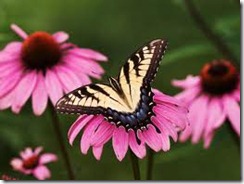The purple coneflower Echinacea purpurea is characterized by blooms with dark-purple centers. Common outer flower colors of purple coneflowers are pink, purple and lavender. While coneflowers are generally healthy, they are susceptible to two damaging pests. The sweetpotato whitefly and Japanese beetle are common coneflower pests that damage the plant’s health and appearance.
Types
-
Sweet potato whiteflies, also known as silverleaf whiteflies, are common coneflower pests. Adults are snow-white moths measuring 1/32 inch in length. They damage flowers by feeding on the leaves. Nymphs are pale yellow and measure 1/25 inch in length. Adult whiteflies are typically found on leaves’ undersides, where they gather to feed in large numbers. Japanese beetles are metallic green in color with copper-colored wings. These beetles measure 3/8 inch in length and 1/4 inch in width. Japanese beetles damage coneflowers in their adult beetle form, as well as in the larval form. The larvae are white, legless grubs that shaped like the letter c. Japanese beetles are typically seen during June and July when they begin feeding on coneflower leaves.
Effects
-
Purple coneflowers infested with the sweetpotato whitefly often develop yellow spots on its leaves and lose leaves prematurely. While feeding, whiteflies extract plant sap from the leaves and excrete honeydew, which is a sticky substance. Honeydew causes sooty mold causing fungi to adhere to the plant’s surface, causing a black, crusty coating of fungus to appear. Coneflowers with Japanese beetle infestations may have skeletonized leaves and a ragged appearance. The larvae feed on the roots, causing reduced vigor.
Cultural Control
-
Washing coneflowers with a forceful stream of water reduces whitefly infestations. Repeat this process twice each week. Remove Japanese beetles by hand if the infestations are small. Hand-picking beetles is most effective if done in the early morning hours when beetles are sluggish. Placing the beetles in a bucket of soapy water kills them.
Chemical Control
-
Heavy whitefly infestations may require horticultural oils to kill adults and nymphs. Oil products must coat the entire plant thoroughly to kill whiteflies. Concentrate on the undersides of plant leaves where whiteflies gather. Horticultural oils also loosen and remove sooty mold fungi. Japanese beetle infestations may require chemical control products if infestations are heavy. Insecticides with the active ingredient deltamethrin or permethrin are effective against adult Japanese beetles. Larvae may require soil drenches. Parasitic nematodes are also available for larval control. Introduce the nematodes into the soil while grubs are small.


Deprecated: strpos(): Passing null to parameter #1 ($haystack) of type string is deprecated in /home/agriviek8Qv/agriviet.net/public_html/wp-includes/comment-template.php on line 2522